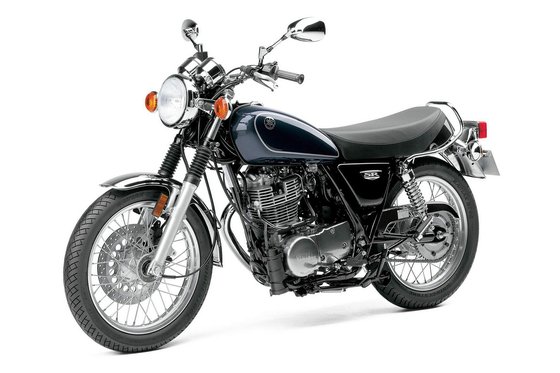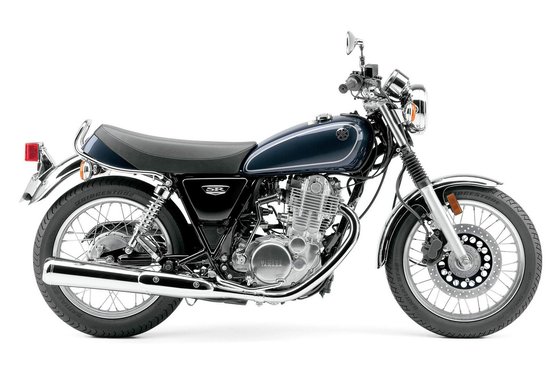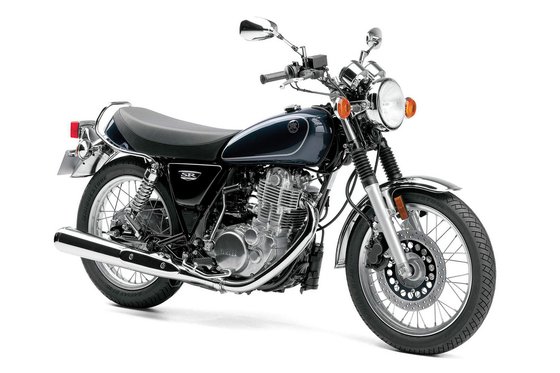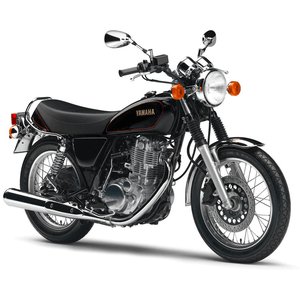Yamaha SR400 (2014-2021): A Timeless Thumper’s Enduring Charm

Introduction
The Yamaha SR400 isn’t just a motorcycle—it’s a time capsule. Produced from 2014 to 2021, this air-cooled single-cylinder machine defies modern trends with its kick-start simplicity, retro aesthetics, and mechanical purity. Riding the SR400 feels like stepping into a café racer’s daydream, where every pulse of its 399cc engine and every flick of its lightweight chassis reminds you why motorcycling was once (and still is) about raw connection.
I recently spent a week with a 2019 SR400 in Retro Green, and it’s clear why this bike has cult status. From its analog instrumentation to its lack of ABS or ride modes, the SR400 demands engagement. Let’s dive into what makes this motorcycle a legend—and why it’s still relevant today.
Design & Aesthetics

The SR400’s design is a masterclass in retro minimalism. Its teardrop fuel tank, spoked wheels, and chrome fenders pay homage to 1970s styling, while the slim steel double-cradle frame keeps the profile lean. At 174 kg (384 lbs), it’s light enough to flick through traffic yet substantial enough to feel planted on open roads.
The 785 mm (30.9-inch) seat height is approachable for riders of all sizes, and the narrow saddle makes it easy to plant both feet firmly. Color options like Onyx, Galaxy Blue, and Matt Black emphasize its understated elegance. Custom builders will appreciate the blank-canvas potential—Yamaha’s Yard Built collaborations, like the WrenchMonkees GibbonSlap and Deus Lightening, prove how easily the SR transforms into scramblers, bobbers, or café racers.
Engine & Performance
The Heartbeat of a Legend

At the core of the SR400 lies a 399cc air-cooled single-cylinder engine, producing 22.9 HP at 6,500 RPM and 27.4 Nm (20.2 lb-ft) of torque at 3,000 RPM. These numbers won’t set speed records, but they’re missing the point. The SR’s charm is in its thump—the visceral vibration and exhaust note that make every ride feel alive.
Fuel injection (added in 2010) ensures reliable cold starts, but the kick-start ritual remains a highlight. Using the decompression lever and piston window, even novices can master the one-kick dance. Once running, the engine settles into a steady idle, its rhythm as comforting as a metronome.
On the road, the SR400 thrives in urban settings. The torquey low-end pulls smoothly from 30 km/h (19 mph) in fifth gear, and the 5-speed transmission shifts with satisfying mechanical clicks. Fuel efficiency is stellar at 3.56 L/100 km (66 mpg), giving the 12L (3.2-gallon) tank a 330 km (205-mile) range—perfect for day trips.
Handling & Ride Experience
Nimble, Light, and Unapologetically Simple
The SR400’s 1,410 mm (55.5-inch) wheelbase and 27.7° rake angle make it agile yet stable. The telescopic front forks and dual rear shocks offer 150 mm (5.9 inches) and 104 mm (4.1 inches) of travel, respectively—enough to handle city potholes but firm enough for spirited cornering.
Drum brakes at the rear and a single 298mm front disc provide adequate stopping power, though modern riders might crave ABS. The 18-inch wheels wrapped in 90/100 (front) and 110/90 (rear) tires strike a balance between grip and classic aesthetics.
Riding the SR400 is a sensory experience. The upright riding position, unshielded engine heat, and cable-operated throttle demand involvement. It’s a bike that rewards patience—you feel every gear change, every bump, and every burst of acceleration.
Customization Potential
Yamaha markets the SR400 as “built to customize,” and the aftermarket agrees. From bolt-on café racer kits to scrambler exhausts, the SR’s simplicity makes modifications accessible. The steel frame accepts aftermarket subframes, and the single-cylinder engine can be tuned for extra pep (though purists will argue it’s perfect stock).
Notable builds include:
- WrenchMonkees GibbonSlap: A stripped-down scrambler with chunky tires and a titanium exhaust.
- Deus Lightening: A tracker-inspired model with a Fox rear shock and SC-Project exhaust.
- Krugger Yard Built: A minimalist bobber with a solo seat and chopped fenders.
Competition
How does the SR400 stack up against rivals in the retro segment?
1. Royal Enfield Classic 350
- Pros: Lower price, electric start, richer heritage.
- Cons: Heavier (195 kg / 430 lbs), less customizable, vibey engine.
- Verdict: The Enfield is more practical, but the SR400 wins on agility and “cool factor.”
2. Suzuki TU250X
- Pros: Fuel injection, electric start, beginner-friendly.
- Cons: Bland styling, less torque (20 Nm), limited aftermarket.
- Verdict: The TU250X is a better commuter, but the SR400 has soul.
3. Honda CB300R
- Pros: Modern tech (ABS, LED lights), 31 HP.
- Cons: Water-cooled engine lacks character, higher seat (800 mm).
- Verdict: The Honda appeals to tech lovers; the SR400 is for purists.
Maintenance
The SR400’s air-cooled engine and straightforward mechanics make it a DIY dream. Key maintenance tips:
- Oil Changes: Every 5,000 km (3,100 miles) with 10W-40 oil (2.4L capacity).
- Valve Adjustments: Check every 10,000 km (6,200 miles). Intake: 0.07–0.12 mm, exhaust: 0.12–0.17 mm (cold).
- Chain Care: Lubricate every 500 km (310 miles); replace 130-link chain when stretched.
- Tire Pressure: 1.75 bar (25 psi) front / 2.0 bar (29 psi) rear.
- Brakes: Bleed hydraulic front brake annually; adjust rear drum as needed.
MOTOPARTS.store Recommendations:
- Upgrade to a high-flow air filter for better throttle response.
- Install a stainless-steel chain for durability.
- Swap the stock exhaust for a lightweight slip-on (like SC-Project) to enhance the thumper sound.
Conclusion
The Yamaha SR400 isn’t for everyone—and that’s its strength. In an era of touchscreen dashboards and ride-by-wire throttles, the SR400 offers a raw, unfiltered connection to riding’s golden age. It’s a bike that demands participation, rewards customization, and thrives in the hands of those who appreciate mechanical honesty.
Whether you’re threading through city traffic, carving backroads, or building a one-off custom, the SR400 proves that some legends never fade—they just kick harder.
Explore our catalog for SR400 upgrades—from performance parts to vintage-style accessories. At MOTOPARTS.store, we keep the spirit of riding alive.
Specifications sheet
| Engine | |
|---|---|
| Stroke: | Four-stroke |
| Max power: | 17 kW | 23.0 hp |
| Max torque: | 27 Nm |
| Fuel system: | Fuel Injection |
| Max power @: | 6500 rpm |
| Displacement: | 399 ccm |
| Max torque @: | 3000 rpm |
| Bore x stroke: | 87.0 x 67.2 mm (3.4 x 2.6 in) |
| Configuration: | Single |
| Cooling system: | Air-cooled |
| Compression ratio: | 8.5:1 |
| Lubrication system: | Wet-sump |
| Number of cylinders: | 1 |
| Valves per cylinder: | 2 |
| Dimensions | |
|---|---|
| Wheelbase: | 1410 mm (55.5 in) |
| Dry weight: | 174 |
| Seat height: | 785 mm (30.9 in) adjustable |
| Overall width: | 750 mm (29.5 in) |
| Overall height: | 1095 mm (43.1 in) |
| Overall length: | 2085 mm (82.1 in) |
| Ground clearance: | 130 mm (5.1 in) |
| Fuel tank capacity: | 12 L (3.2 US gal) |
| Drivetrain | |
|---|---|
| Final drive: | chain |
| Chain length: | 130 |
| Transmission: | 5-speed |
| Rear sprocket: | 56 |
| Front sprocket: | 19 |
| Maintainance | |
|---|---|
| Rear tire: | 110/90-18 |
| Engine oil: | 10W40 |
| Front tire: | 90/100-18 |
| Break fluid: | DOT 4 |
| Spark plugs: | NGK BPR6ES or NGK BPR6EIX |
| Spark plug gap: | 0.8 |
| Forks oil capacity: | 0.408 |
| Engine oil capacity: | 2.4 |
| Engine oil change interval: | Every 5000 km or 2 years |
| Valve clearance (intake, cold): | 0.07–0.12 mm |
| Valve clearance check interval: | 24,000 km / 15,000 mi |
| Valve clearance (exhaust, cold): | 0.12–0.17 mm |
| Recommended tire pressure (rear): | 2.00 bar (29 psi) |
| Recommended tire pressure (front): | 1.75 bar (25 psi) |
| Additional Features | |
|---|---|
| Starter: | Kick-start with decompression lever |
| Factory warranty: | 1 Year Limited |
| Customization notes: | Renowned for café racer, bobber, and scrambler conversions |
| Chassis and Suspension | |
|---|---|
| Frame: | Steel Double Cradle |
| Trail: | 112 mm (4.4 in) |
| Wheels: | Wire-spoked |
| Rear tire: | 110/90-18 |
| Front tire: | 90/100-18 |
| Rear brakes: | Drum |
| Front brakes: | 298 mm single disc, hydraulic caliper |
| Rear suspension: | Dual shock swingarm |
| Front suspension: | Telescopic fork |
| Rake (fork angle): | 27.7° |
| Rear wheel travel: | 104 mm (4.1 in) |
| Front wheel travel: | 150 mm (5.9 in) |



















